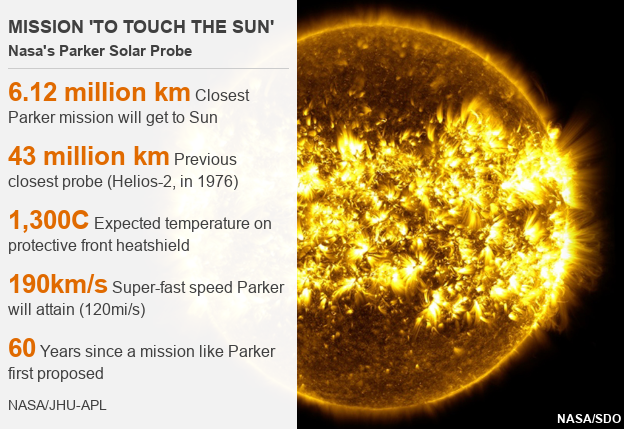Parker Solar Probe: Nasa's Sun mission smashes records
- Published

Artwork: Parker must always keep its heatshield pointed at the Sun
America's audacious mission to "touch the Sun" has now got nearer to our star than any previous human-made object.
The Parker Solar Probe passed the current record of 42.73 million km (26.55 million miles) from the Sun's surface on Monday.
The previous record was set by the German-US Helios 2 satellite back in April 1976.
That mission also set the all time speed record of close to 70km/s (43 miles/s). Parker will smash this, too.
The expectation is that it will eventually reach peak speeds around 190km/s (690,000km/h; 428,700mph).
Parker was launched from Earth in August. It's on a trajectory that will take it inside the Sun's outer atmosphere, or corona.
Information from this region promises to crack longstanding mysteries about our star's behaviour.
Parker's elliptical orbit will edge closer to the Sun over the coming years. At its closest approach, the probe will get to just 6.12 million km (3.83 million miles) from the star's broiling "surface".

Parker scientist Dr Nicky Fox: "Never before have we gone up and literally touched our star"
Why is this mission important?
Parker will help us better understand how the Sun works.
The star is constantly bombarding the Earth with charged particles and magnetic fields. This perpetual flow, or "solar wind", is responsible for generating the beautiful auroral lights that appear in polar skies, but there are some interactions that initiate much more troubling effects.
The biggest outbursts from the Sun will rattle the Earth's magnetic field. In the process, communications may be disrupted, satellites can be knocked offline, and power grids will be vulnerable to electrical surges.
Scientists try to forecast these "storms" and Parker promises new and valuable information to help them do that.

The diffuse corona is only visible to us on Earth during a total solar eclipse
Why go so close to the Sun?
Parker wants to get where the action is.
The corona is a remarkable place. It's strangely hotter than the Sun's actual surface, or photosphere. While this can be 6,000 degrees, the outer atmosphere may reach temperatures of a few million degrees.
The mechanisms that produce this super-heating are not fully understood.
Likewise, the corona is the place where the solar wind gets its big kick in speed, sweeping out across the Solar System at more than 500km/s (a million mph).
Parker aims to solve these puzzles by directly sampling the corona's particle, magnetic and electric fields.
Jonathan.Amos-INTERNET@bbc.co.uk, external and follow me on Twitter: @BBCAmos, external